Disclosure: We may earn a small commission if you choose to buy a product through links on our site. Learn...
 Klara Nilsson | Updated on June 17, 2023
Klara Nilsson | Updated on June 17, 2023
This guide explains the different types of knitting yarn and how they differ in fiber, material, and usage. You’ll learn about natural versus synthetic yarns, their pros and cons, and how to choose the right yarn type for your projects.

Yarns can be made of dozens of different fibers, blends, and materials that can be hard to differentiate. If you’re a beginner, this can make shopping for yarn pretty difficult – how are you supposed to know the difference between animal, plant, and synthetic fibers? More to the point, how will you know what kind of textile each yarn type will produce?
In this guide, we explain the different types of knitting yarn and how they can affect your knitting.
We’ll cover yarn fiber types and materials, and explain which knitting projects each yarn type suits best. We’ve also included pictures of all the different yarn types to help you understand their texture and appearance.
At the end of this guide, we’ve even put together a yarn type comparison chart to help you compare the different types of yarn. Once you’ve read through your options, you’ll be in a better position to read yarn labels and choose the right type of yarn for your next project.
Types Of Yarn (Yarn Fibers & Materials)
Knitting yarns are composed of different fibers and materials, all of which have their own unique qualities. You can choose between natural or synthetic fibers, which vary in price, texture, and usability. The way you block your knitting will also depend on the yarn fiber type you’re using.
As the name suggests, natural yarn fibers such as wool, cotton, and silk are produced from plants or animals. Synthetic fibers such as acrylic or polyester are man-made. Most manufacturers blend both natural and synthetic fibers to create yarns with certain desirable characteristics such as softness.
You’ll be able to see the breakdown of these blends on your yarn label (e.g. 57% Wool, 33% Acrylic, 10% Cashmere).
Most beginners start with a wool blend because it’s cheap, versatile, and stretchier than synthetic fibers like acrylic. Variegated yarn is also recommended for newbies as the alternating colors help you to see individual stitches more clearly. For more information on stitch definition and yarn appearance, read our guide to yarn texture types.
Now, we’ll explain every type of knitting yarn in detail – let’s start with common natural fibers.
Natural Yarn Types (Animal and Plant Fibers)
Natural yarns are produced using naturally-occurring materials from plants and animals. Animal yarn fibers are particularly good for warm winter knitwear due to their excellent insulating properties, though they’re unsuitable for vegans and some people can find them itchy.
Organic plant-based fibers such as cotton and silk aren’t as warm as animal-based alternatives, they’re often more breathable, absorbent, and non-allergenic.
Here’s a list of common natural yarn types and their pros and cons:
Wool
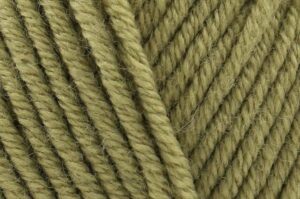
| Warm, breathable, and highly-insulating | Can be itchy |
| Comes in many types and variations | Can trigger allergic reactions |
| Durable and easily-stretched | Sometimes vulnerable to pilling |
| Versatile and Easy to wash | Common and affordable |
Wool is the most common yarn fiber for knitting. Made from the fleece of sheep, woolen yarns come in multiple varieties and are typically used for close-fitting sweaters, scarves,heavy blanket kits, and more. Wool is highly-insulating, breathable, and warm, but it can be itchy and cause allergic reactions.
This fiber type usually requires less washing than alternatives, and will retain the shape it dries into when stretched and blocked. To care for knitted garments made using wool, simply hand wash them in warm water.
Wool is often blended with other fibers for improved durability. It can be easily dyed into a variety of colours and is generally quite resistant to moisture. However, it can be vulnerable to pilling and it can felt easily if you machine wash it.
Here are the most common types of wool fiber:
- Merino Wool: A superfine wool variation that comes from the Merino sheep. It is one of the softest types of wool – popular for its texture, breathability, and versatility. It is often reported that merino wool is less scratchy than traditional wool, but it can pill over time.
- Shetland Wool: Shetland wool comes from sheep native to Scotland’s Shetland Islands. It is soft, shiny, and thicker than merino wool, which makes it an excellent choice for big fluffy sweaters. However, it can be itchy when worn close to bare skin.
- Organic Wool: Organic wool is not chemically treated, processed, or altered. This applies to both the yarn itself and the sheep it comes from: the livestock are usually healthy animals that are not dipped or treated with antibiotics. Organic wool can be expensive and delicate but it’s great for the environment and animal welfare.
- Wool Blends: Manufacturers often blend pure sheep’s wool with other yarn types such as alpaca, silk, or acrylic. This is usually done to create a yarn with complimentary features such as durability and softness. Wool is most commonly blended with cotton.
Though these are the most common wool yarn types, there are many more types of sheep’s wool used in knitting. Lamb’s wool, for example, comes from the first shearing of a young sheep. Icelandic wool is a soft variation from Icelandic sheep, and pure or “virgin” wool comes directly from the fleece of an animal (it is not recycled).
Finally, washable or “superwash” wool is treated to prevent the buildup of a fuzzy outer layer.
Alpaca
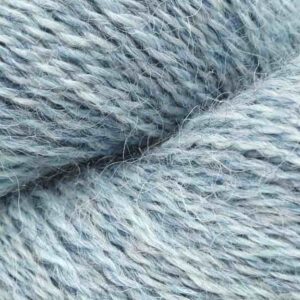
| Soft and luxurious | Can be expensive |
| Very warm and durable | Felts or “pills” easily |
| Hypoallergenic | Can “grow” and lose its shape over time |
Alpaca yarn fibers are soft and fine with a small diameter and hollow threads. This creates an incredibly soft, luxurious texture that is highly-insulating and much warmer than sheep’s wool. The Alpaca Lace Yarn is a popular default alpaca yarn if you’re looking to get started.
Alpaca wool is durable and traps heat well, but it does not hold its shape as well as other wool types. Alpaca fleece can be lighter or heavier depending on how it is spun. It does not contain lanolin, which makes it a hypoallergenic yarn that’s great for babies or sensitive skin.
Its warmth makes it a staple for winter clothing. However, most knitters use an alpaca blend as pure alpaca garments can get extremely hot, and the blend can strengthen the tension. Alpaca fibers take dye well, but the yarn is usually more expensive than regular wool and it can easily felt if machine-washed.
Cashmere
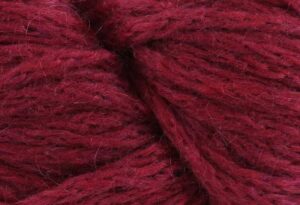
| Soft, luxurious, and non-irritating | Very expensive |
| Warm and highly-insulating | Pure cashmere yarns are rare |
| Gets softer with wear | Weaker than other animal fibers |
| Prone to pilling |
Cashmere is a high-quality yarn that is incredibly soft and fluffy to the touch. Cashmere fibers are incredibly fine and actually get softer with wear. Though it has become synonymous with luxury, cashmere is also infamously expensive and weaker than conventional wool.
Pure cashmere is expensive largely due to its scarcity. It is combed and collected from the undercoat of Cashmere or ‘Kashmir’ goats in South Asia, which only shed once a year. This process is not easy, and each goat does not yield a lot of wool. In fact, it can take the fibers of up to four goats to yield the yarn for one single knitted sweater.
Cashmere yarn is soft, pleasant to the skin, and warm. However, it easily pills and isn’t quite as breathable as other animal yarn fiber types. If you do choose to knit a cardigan or hat using cashmere wool, make sure to stick to dry cleaning as opposed to machine washing.
We’ve collected a range of kits that contain cashmere yarn in our cashmere knitting kit collection, and there are even a few in our curated selection of hat knitting kits. They’re notoriously expensive though, which is why most manufacturers recycle or blend cashmere with other fibers to extend their supply.
If you’re looking for 100% pure cashmere knitting yarn, we recommend Cashmere Premium by Lang Yarns.
Mohair
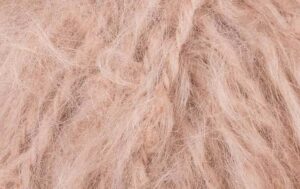
| Fluffy, warm, and soft | More expensive than wool |
| Strong and highly-durable | Can be irritating to the skin |
| Shiny and glossy appearance | Fuzzy texture can be hard to knit with |
| Elastic and absorbent |
Mohair yarn is shiny, lightweight yarn with a fluffy, soft texture that some people find irritating to the skin. Despite its airiness, mohair is warm and highly durable and is often held double with other fibers to add weight and tensile strength. Rowan Kidsilk Haze is a good example of a popular mohair yarn.
Mohair is an animal fiber that is produced from the hair of Angora goats. It is highly absorbent and breathable, which makes it great for sweaters and scarves for all seasons. It has a shiny, glossy appearance that can be easily dyed into lots of different colors.
Most modern knitting patterns blend lace weight mohair fibers with silk, nylon, or other types of wool to create a strong fluffy yarn. These blends benefit from mohair’s lightness whilst maintaining warmth and mohair’s unique sheen.
This yarn type is highly-elastic and maintains its original shape easily, but it is typically quite expensive. It can also be hard to knit due to its fuzziness, which makes it difficult to create defined stitches. For this reason, mohair is best knit with non-textured knitting needle types like metal knitting needles, as they catch on the fibers less often.
Angora
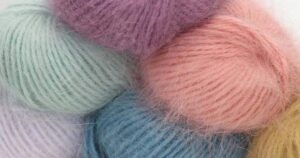
| Extremely soft and fluffy | Very expensive |
| Much warmer than sheep’s wool | Slippery and difficult to knit with |
| Shiny, with a signature ‘halo’ effect | Stains easily |
| Doesn’t hold odours for long |
Another animal fiber, Angora wool is a fine yarn type that is produced from the hair of Angora rabbits. It is similar to cashmere in softness and equally (if not more) expensive, but it is up to seven times warmer than normal sheep’s wool.
Angora yarns are fluffy and shiny like mohair, which can make them difficult for beginners or knitters trying to create intricate stitches with good definition. It can be slippery to work with, so we recommend using a set of textured needles for good grip on the yarn strands.
Its softness and luxurious texture makes Angora one of the most expensive yarns on the market. However, its lack of elasticity means it is normally found blended with other fibers such as sheep’s wool or acrylic to improve its stretchiness and weight, such as the Bare Hare range from KnitPicks. It stains easily, but it doesn’t hold odours as powerfully as other animal fibers.
Llama
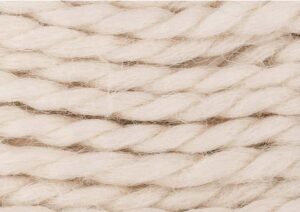
| Highly-insulating and warm | Not very stretchy |
| Lightweight relative to its warmth | Scarcer than alpaca wool |
| Does not contain lanolin |
Llama yarn is very similar to alpaca yarn. Great for chunky sweaters, the fibers are also hollow and free from the allergenic lanolin chemical. This means that clothes knit with llama yarn are light in weight whilst still holding a lot of warmth.
The fleece of a llama actually comes in two forms: the inner coat and the outer coat. The outer coat produces coarse, thick fibers typically used for ropes and thick projects like throws. The inner coat is much softer, and it is this hair that is usually spun for knitting yarn.
Cotton
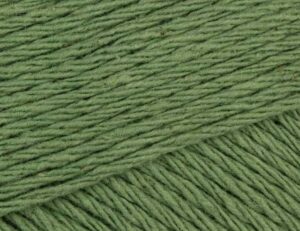
| Light, breathable, and absorbent | Not as warm as other yarn types |
| Very strong and durable | Can split during knitting |
| Smooth fibers don’t obscure stitchwork | Lacking in elasticity |
| Machine-washable | |
| Comes in a huge variety of colors |
Cotton is a plant-based yarn fiber that is strong, lightweight, and inexpensive. Due to its absorbent qualities and breathability, cotton is often used to knit light summer clothes or dishcloths, as well as projects that require clearly-defined stitches. It’s also a great choice if you’re allergic or irritated by animal-based yarns.
Unlike fuzzy animal fibers, cotton fibers are extremely smooth. This makes it an excellent yarn for amigurumi. Popular cotton yarns such as Sirdar Cotton DK are machine-washable and take dye very easily.
Cotton is soft, breathable, and kind to sensitive skin, which means it is often used for knitted baby clothes and blankets. In fact, our list of baby blanket knitting kits for beginners features a wide range of kits that use cotton yarn. Cotton is also common in bucket hat knitting patterns as its durability helps maintain the shape of the brim.
There are three main types of cotton yarn:
- American Cotton: Standard cotton with mid-length fibers and a huge variety of colors.
- Egyptian Cotton: Usually more expensive, with a soft, smooth texture and long fibers.
- Pima Cotton: A middle ground between American and Egyption cotton types.
Though strong, cotton yarns are fairly rigid and do not have much elasticity, especially compared to animal fibers like wool. This means it does not hold its shape well when blocking, and it can sag if worn for a long time. For this reason, it is usually blended with stretchier fibers.
Silk
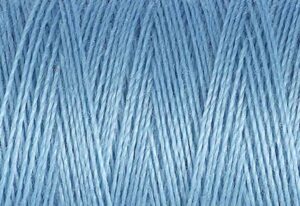
| Strong and durable | Very expensive |
| Extremely soft and ‘silky’ | Slippery for beginners |
| Excellent stitch definition | Susceptible to static and catching |
| Versatile in temperature |
Arguably the most expensive yarn type of all, silk yarns are strong, shiny, and smooth to the touch. Usually worked in fine or superfine weights, silk fibers give excellent stitch definition and a signature sheen to knitted garments. Silk yarns are light and breathable, but they can also offer insulation if blended with other fiber types.
Much like cashmere, silk is expensive because the procurement process is labour-intensive. The substance is taken from silkworms, and each worm produces a miniscule amount of silk.
Silk is suitable for hand washing or dry cleaning, and it’s great for lacy knitted garments on small knitting needle sizes. However, it is quite slippery to work with and it can be susceptible to catching. For these reasons, it’s not the easiest yarn type for beginners.
Due to its price, pure silk knitting yarns like Knitting for Olive’s Pure Silk range are relatively rare. Instead, silk is usually mixed with other fibers such as merino wool, alpaca, and cashmere to create luxurious super-soft blends such as Sirdar Cashmere Merino Silk DK.
Linen
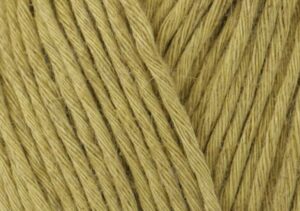
| Highly-absorbent and breathable | Creases and wrinkles easily |
| Heat-resistant | Not very warm |
| Strong and lightweight | More elastic than cotton fibers |
Linen fibers have been spun to create clothing for thousands of years. Another plant-based fiber type, linen yarns absorb moisture very easily and are extremely robust against high temperatures.
The yarn is strong and light, but it creases and wrinkles very easily. Compared to cotton fibers, linen is much more elastic and softens in warm water. This makes it much better for blocking.
It’s commonly used for breathable summer clothing and lace knitting.
Bamboo
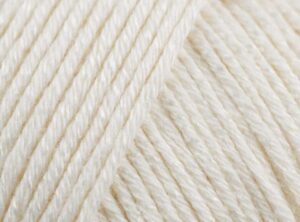
| Lightweight and breathable | Not as warm as other fibers |
| Non-allergenic | Less durable |
| Reportedly anti-bacterial | Can be expensive |
| Environmentally-friendly |
A naturally-occurring fiber, bamboo yarns are relatively new to the market. They are typically used in lightweight knitting projects to create cool, breathable summer clothing.
Bamboo yarn can be incredibly soft, and its non-allergenic properties make it a good choice if you or the person you’re knitting for is sensitive to wool. It is more absorbent than cotton and often considered to have antibacterial properties, too.
Importantly, bamboo fibers are eco-friendly and highly sustainable. The yarn is biodegradable and comes from a renewable resource, which often makes popular bamboo yarns like Stylecraft Naturals Bamboo Cotton DK the first choice for environmentally-conscious knitters.
Hemp
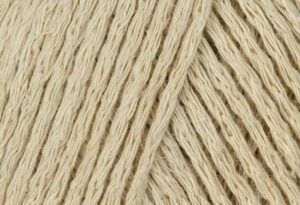
| Extremely strong and durable | Not as comfortable and fluffy |
| Cheap and affordable | |
| Good stitch definition |
Hemp is another natural yarn fiber that is relatively new to the knitting world. It is softer than you might expect and extremely sturdy.
Thanks to its durability, hemp is most commonly used for tough projects like coats, boot socks, and dishcloths. It can easily be used for softer projects too though, and it produces excellent stitch definition.
If you’re looking for cheap knitting yarn, hemp yarns like Buddy Hemp by Wool and the Gang are great alternatives to cotton. Hemp plants produce significantly more fibers than cotton, which means the yarn is a lot more affordable.
Synthetic Yarn Types (Man-Made Yarn Fibers)
Synthetic yarns are created with chemicals rather than naturally-occuring substances. They’re usually much cheaper than animal or plant-based yarn types, and they’re typically easier to maintain, too.
Acrylic
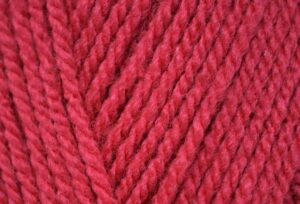
| Retains heat well | Non-absorbent |
| Cheap and durable | Not as breathable as animal fibers |
| Machine-washable | Doesn’t feel as soft |
Acrylic is a common man-made fiber that is sometimes referred to as “imitation wool” for its heat-retention properties. It’s usually much cheaper than natural fibers, which makes it a great choice for beginners looking to practice their first knitting projects.
Though it is warm and strong, acrylic isn’t as absorbent or breathable as sheep’s wool. However, its toughness makes it machine-washable, which means it’s a common choice for items you’ll need to wash over and over again.
Many manufacturers use acrylic yarns to create fake fleeces and furs cheaply. Likewise, a lot of knitters start off with acrylic yarn and then move onto natural fibers once they’re more skilled.
Polyester

| Strong and durable | Chemically-processed |
| Very affordable | Bad for the environment |
| Machine-washable | Can feel scratchy on the skin |
Polyester is a synthetic yarn made from a blend of plant extract, petroleum, and coal, which means it isn’t very environmentally-friendly. It is a durable substitute for wool, and is often used in place of animal fibers for those with allergies.
Polyester is commonly blended with other fibers like wool and cotton for additional strength and to protect against shrinkage. It’s tough, super easy to care for, and machine-washable. However, some people can find that pure polyester feels scratchy on their skin.
Rayon

| Shiny and smooth | Lacks elasticity |
| More affordable than silk | Doesn’t retain heat |
| Breathable | Chemically-processed |
Rayon fibers are halfway between synthetic and plant-based. The material is made and processed using a blend of reconstituted wood pulp and chemicals such as sodium hydroxide.
Most rayon yarns are shiny and smooth to the touch. Some yarn manufacturers even use rayon or nylon to imitate the characteristics of natural fibers like silk.
Unlike wool, rayon is a cool and breathable material that conducts heat away from the body rather than retaining it, which makes it more suitable for summer knitwear. It lacks elasticity though, which means it doesn’t hold its shape well over time.
Nylon

| Cheap alternative to silk | Can be scratchy |
| Shiny and smooth | Chemically-processed |
| Very strong and durable | Not as soft as animal fibers |
| Machine-washable |
Nylon is another synthetic yarn type that is designed to offer a cheap alternative to silk. Similar to rayon, it is shiny, easy to wash, and incredibly strong.
This fiber type is often blended with weaker fibers such as merino or alpaca wool. In this case, the synthetic yarns add strength and durability to otherwise delicate garments. Nylon is also commonly used to make carpets and rugs.
Yarn Fiber Blends
Most of the yarn you’ll come across in stores or online will be blended. That means the ball of yarn is made from more than one kind of fiber in different proportions. For example, it might be 60% sheep’s wool and 40% acrylic.
FIber blending is used to create yarns with the best characteristics of different fibers, without their weaknesses.
Novelty yarns are used to add textures, colors, and properties to knitted materials. They’re usually made of synthetic fibers like polyester, and are considered in a separate category to conventional yarn types.
Though they may seem fun, novelty yarns are usually much more difficult to work with than normal knitting yarns. They’re typically highly-textured, which makes it much harder to identify individual knitting stitches.
Here’s a list of common novelty and specialty yarn types:
- Ribbon Yarn: Designed to look like craft ribbon, ribbon yarn is a type of novelty yarn usually made from rayon or nylon. It’s great for accessories, but it can be fiddly to knit with. Railroad ribbon looks similar, with small fibers joining two yarn strands like a train track.
- Self-Striping Yarn: A favourite amongst beginners, self-striping yarn has multiple colors spun together into one strand. This means the item you’re knitting will gradually change color as it progresses, without you having to switch between yarns.
- Bouclé Yarn: This novelty yarn is composed of irregular knots and loops. It is typically made from cotton or wool fibers and has a bumpy texture.
- Chenille Yarn: This type of yarn is soft and has a texture like velvet. Chenille actually means ‘caterpillar’ in French, which refers to the yarn’s furry texture.
- Faux Fur: Manufacturers use fluffy fibers on a base of nylon to create a novelty yarn that looks like animal fur.
- Marled Yarn: Used to add texture to knitted projects, marled yarns are made by twisting plies of various colors together. They can be made with any number of plies to form a single yarn strand with different colors swirling around each other.
- Variegated Yarn: Unlike conventional yarn, variegated yarns are dyed in multiple different colors or shades of a single color.
- Thick-Thin Yarn: As the name suggests, these novelty yarns alternate between thick and thin sections. This creates a bumpy, textured look in knitted fabrics.
- Tweed Yarn: This specialty knitting yarn can be made out of lots of different fibers. Tweed yarns have a primary background color that is speckled with tiny bits of fiber in other colors.
- Heather Yarn: This specialty wool yarn is created by spinning multiple shades of yarn together to create a single fleece in a unique color.
- Eyelash Yarn: Usually made from polyester or other synthetic fibers, eyelash yarn is a novelty material with long fluffy strands poking out from a central thread to create the look of eyelashes.
If you’re a beginner, the best way to choose a yarn type is simply to keep knitting. Try out a few different knitting patterns and see how different fibers feel. Preferences when it comes to yarns are the same as fashion preferences – what works for you might not work for others!
If you are following a specific knitting pattern, it’s best to use the yarn fiber and weight specified in the instructions. Changing the yarn can have a significant impact on the final results of the pattern, so using the suggested yarn or an exact substitute is sensible if you don’t want a surprise result.
Most designers include the yarn weight, brand, or fiber type in their knitting patterns. If you find a pattern on our website, we’ll also list the suggested yarn so you don’t have to go looking. If you decide to use a different yarn fiber or weight, be aware that your results might look significantly different to what you’re expecting.
If you’re knitting something unique and original, here are a few key things to consider when choosing a yarn type:
- When will you wear the final item? Do you want it to be warm and cosy, or cool and breathable?
- What texture do you want it to have? Does it need to be smooth and durable, or soft and fluffy?
- Do you need the final item to be machine-washable?
- Is the final item designed to be worn by a baby, or someone with sensitive skin?
- What color will the knitted item be?
- How much do you want to spend on yarn?
Consider these questions and compare each yarn type using the pros and cons tables in the previous section. Using the information in this guide, you’ll be able to find a yarn fiber type and material that suits your needs perfectly.
Remember, always knit a swatch before you embark on your full project, whether you’re using a knitting pattern or not. This will help you test the yarn and needles you’re using to make sure you’re knitting with the right tension.
Yarn Type Comparison Chart
Using the chart below, you can compare fifteen common yarn types based on their fiber type, materials, and description.
| Yarn Name | Fiber Type | Description |
|---|---|---|
| Sheep Wool | Animal Fiber | Warm, affordable, and versatile yarn found almost everywhere. |
| Alpaca Wool | Animal Fiber | Silky and super soft animal fiber that’s a little more expensive than sheep’s wool. |
| Cashmere Wool | Animal Fiber | Lightweight but highly-insulating and luxurious yarn. |
| Llama Wool | Animal Fiber | Warm and highly-insulating animal fiber that can lack elasticity. |
| Mohair | Animal Fiber | A superfine yarn fiber with a shiny appearance and fluffy texture. Commonly blended with wool. |
| Angora | Animal Fiber | Extremely delicate, soft and fluffy animal yarn that can be expensive. |
| Silk | Animal Fiber | A luxurious, lightweight, and fine fiber that is incredibly strong for its weight and very expensive too. |
| Cotton | Plant Fiber | The most popular plant-based yarn fiber. Soft, strong, and breathable. |
| Linen | Plant Fiber | Highly-absorbent, cool, and breathable yarn used for summer knits and made from flax. |
| Bamboo | Plant Fiber | Environmentally-friendly plant-based yarn that is strong and naturally antibacterial. |
| Hemp | Plant Fiber | Incredibly tough and durable natural yarn that can be coarse. Commonly used for dishcloths and coats. |
| Acrylic | Synthetic Fiber | Warm, lightweight, and similar to wool. One of the most popular synthetic yarns in crafts. |
| Polyester | Synthetic Fiber | Often blended with natural fibers to reduce shrinkage and add strength. |
| Rayon | Synthetic Fiber | Cool, breathable, and shiny – similar to nylon. |
| Nylon | Synthetic Fiber | Shiny and smooth, often used to imitate silk. |
What’s the Best Knitting Yarn for Allergies and Sensitive Skin?
If you’re knitting an item of clothing for a baby or someone with allergies and sensitive skin, it’s best to use yarns with primarily plant-based or synthetic fibers. These fiber types do not contain lanolin or other allergy-inducing chemicals.
It’s also best to use a yarn type that is soft, breathable, and gentle on the skin like cotton. Some popular yarns like mohair and polyester can feel scratchy and uncomfortable, even if they’re not allergy-inducing.
What’s the Best Yarn Type for Beginners?
Most beginners will start with chunky wool yarns and big knitting needles. Truthfully, yarn types don’t have a huge impact on knitting difficulty, though novelty yarns can be complicated to work with. Wool is simply an affordable and common yarn type that is easy to work with.
If you’re a beginner, start out with easy knitting patterns and use the exact yarn that is recommended by the designer. Once you’ve tried a few patterns, you can begin substituting yarns to find out how different fiber types feel to knit with. If you’re interested in learning more, popular knitting classes often include lessons on yarn types and tools.
Types of Yarn: Printable Summary
In the chart below, we’ve summarized the different types of knitting yarn and how they differ. Pin it, print it out, or download it — we hope it’s useful!
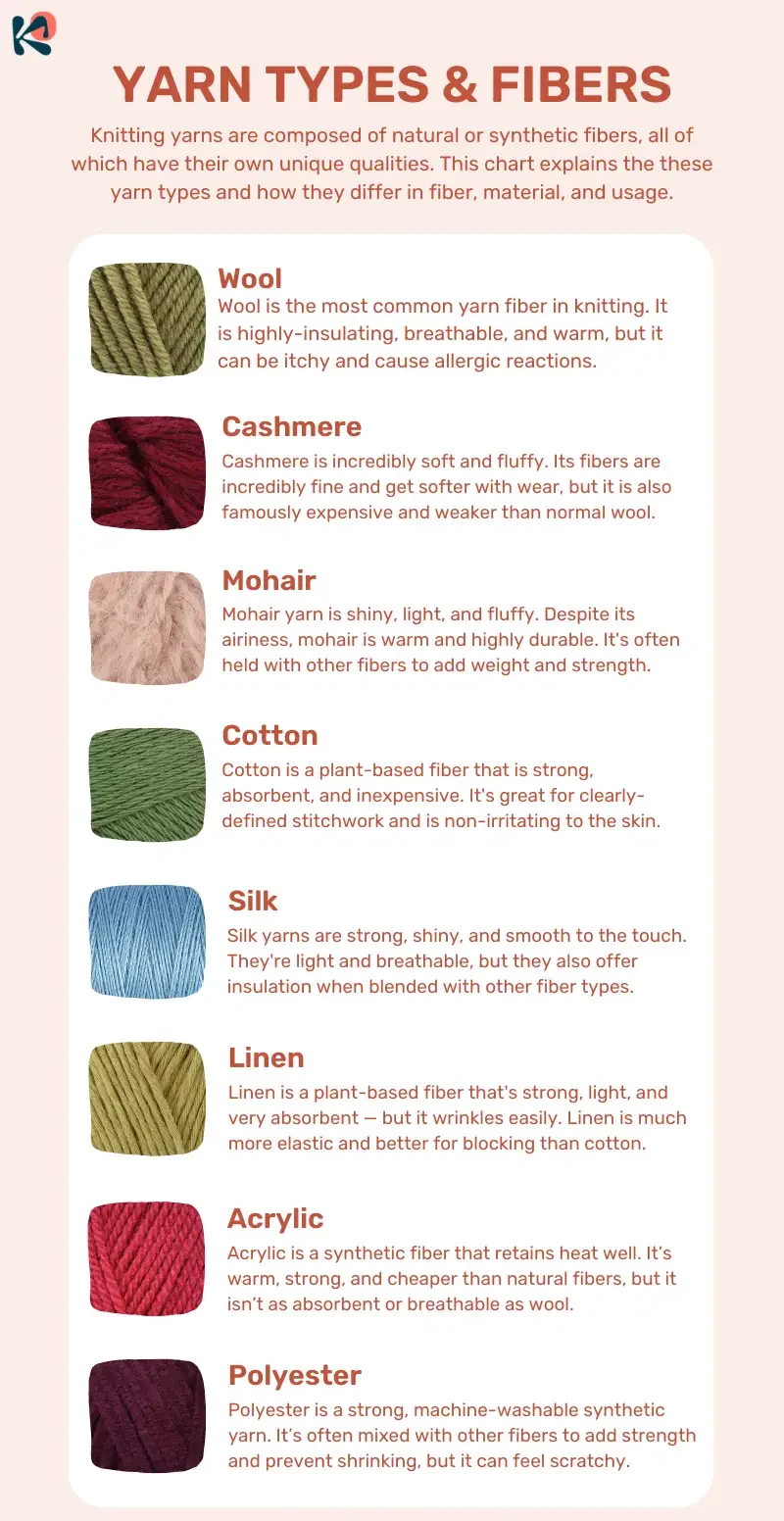
Related Guides
Slouchy Beanie Knitting Pattern
Disclosure: We may earn a small commission if you choose to buy a product through links on our site. Learn...
How to Knit a Stocking Guide: A Comprehensive Step-by-Step Tutorial for Beginners and Beyond
Disclosure: We may earn a small commission if you choose to buy a product through links on our site. Learn...
